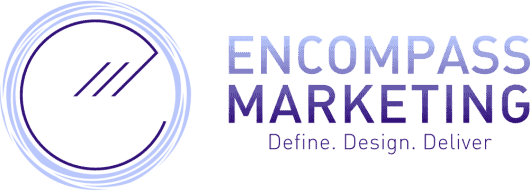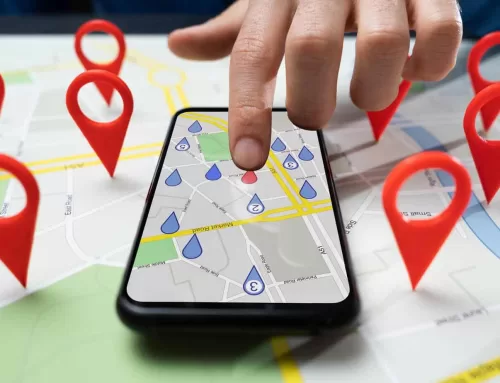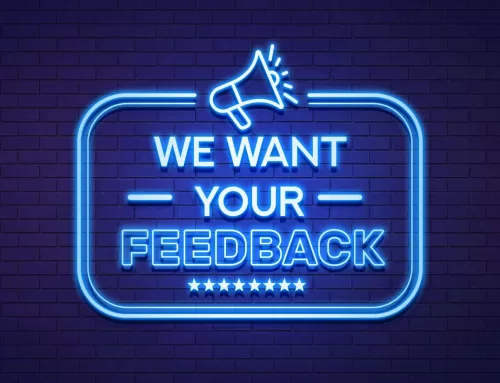This blog is courtesy of Alex Chris at reliablesoft.net
Think about the last time you visited a website with amazing web content. How did they do it? What steps did they make to build a seamless content strategy?
This guide will answer all of your questions about writing for the web. You’ll learn how to build a website content strategy that aligns with your long-term vision in 10 steps.
Let’s get started.
10 Steps for Creating Remarkable Website Content
These are the steps to follow to create amazing website content.
- Identify the purpose of the website content
- Research your audience and their needs
- Perform a website content audit
- Create content that is better and different than competitors
- Make your content discoverable
- Demonstrate your experience and expertise
- Speak the user’s language
- Optimize for SEO
- Give user’s options what to do next
- Update your content to stay relevant to search queries
1. Identify the purpose of the website content
This first step is simple, yet crucial. You can think of your web content purpose like your mission.
Everything you create expands on your mission—it’s the backbone of your website content strategy. In other words, your content purpose is your why.
If your content doesn’t have a purpose, why are you creating it?
The following 3 questions create a unique, driven, and helpful content purpose. Reference back to your answers as you create your content strategy.
Why is your content important?
Let’s say you own a digital marketing agency and want to write about digital marketing related topics. Ask yourself why this would be useful for your audience.
What will your readers take away from your posts?
Who needs to hear about it?
Consider who needs to learn about digital marketing. Write down your audience and why your content will make their lives better (we’ll go over how to research your audience in step 2.)
How will my content be different from others?
There are hundreds of posts about digital marketing. What makes yours different?
Use your own business, brand, and personality to stand out. Bring something new to the table.
On another note, it’s easy to veer away from your purpose when you produce a lot of content.
This keeps your content true to your purpose and your readers.
2. Research your audience and their needs
A big part of your website content strategy is to build long-lasting customer relationships. Your web content should answer your audience’s questions and relate to their needs. It’s about them, not you.
Here’s another tip—when you research your audience, be as specific as possible.
A general audience leads to generic content—you’ll lose your content purpose and what makes you different. A specific audience, on the other hand, connects your purpose with their desired goals.
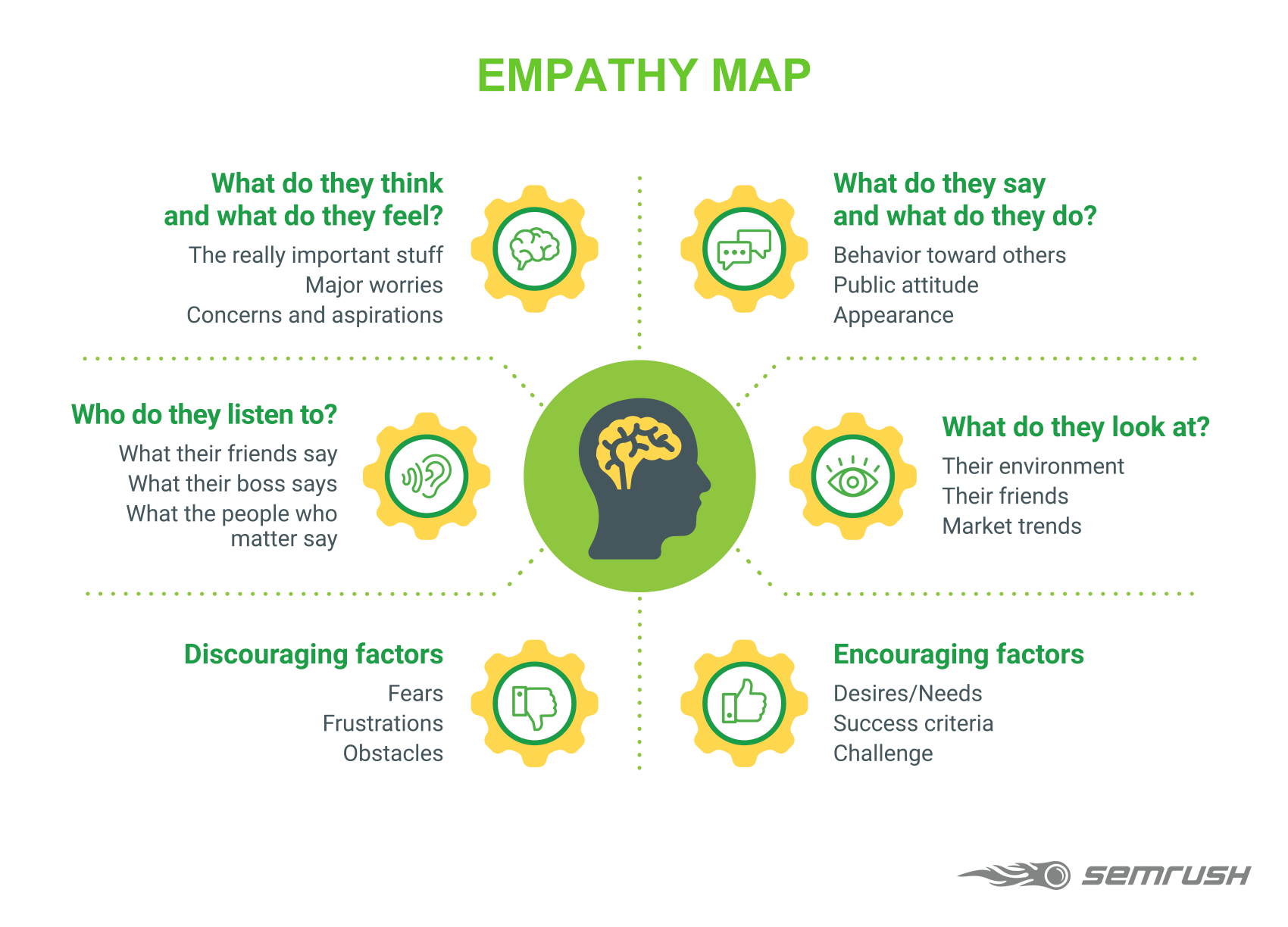
As you research your audience, write down the following traits.
Pain points – Your reader’s challenges give you a list of questions to answer in your content. Become their problem-solver.
Behavior – Write down the behavior of your audience as a customer, and as a person.
As a customer – Research what they purchase, when they purchase, and why.
As a person – Write down what they do during their free time. What are their hobbies? Do they read other blogs? If so, what?
Find out what grabs their interest and use it.
Desires – What are your audience’s long-term goals? How will you lead them there?
Demographics – The age, occupation, gender, etc. of your reader will personalize the way you write and where you publish content. For example, a 15-year-old is more likely to use Instagram than a 65-year-old.
Once you’ve researched your audience, build your web content around the stages of your marketing funnel.
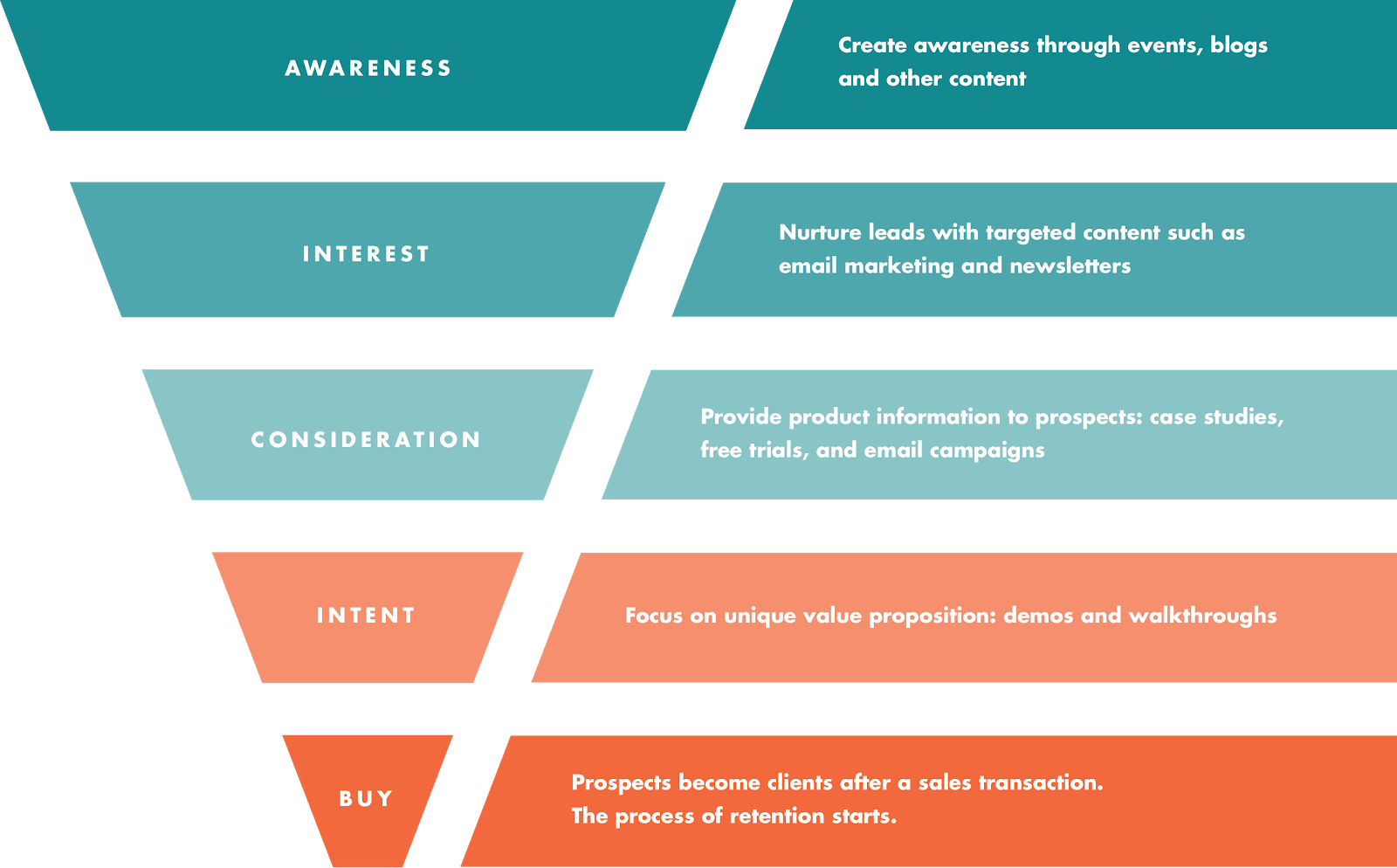
You should create content for each stage. Use your reader’s interest to get their attention during the delight stage. Or, nurture your readers into buying your product with their desires.
3. Perform a website content audit
Writing for the web is trial and error. You’ll notice how some posts receive higher engagement than others over time.
Auditing your website content creation helps you:
- Identify missing topics
- Align your website purpose and content
- Analyze post engagement
- Readjust SEO
Try to audit your website content every 6 months. This will ensure you’re on track with your goals.
The easiest and most efficient way to perform a content audit is to make use of a tool. In this example, I’m going to use SEMRush Content Audit – if you’re not a SEMRush subscriber you can register now and get a 14-day free trial.
Here is an overview of the process:
Login to your SEMRush account, create a new project, and go to Content Analyzer.
SEMRush will analyze your content and group them into content sets.
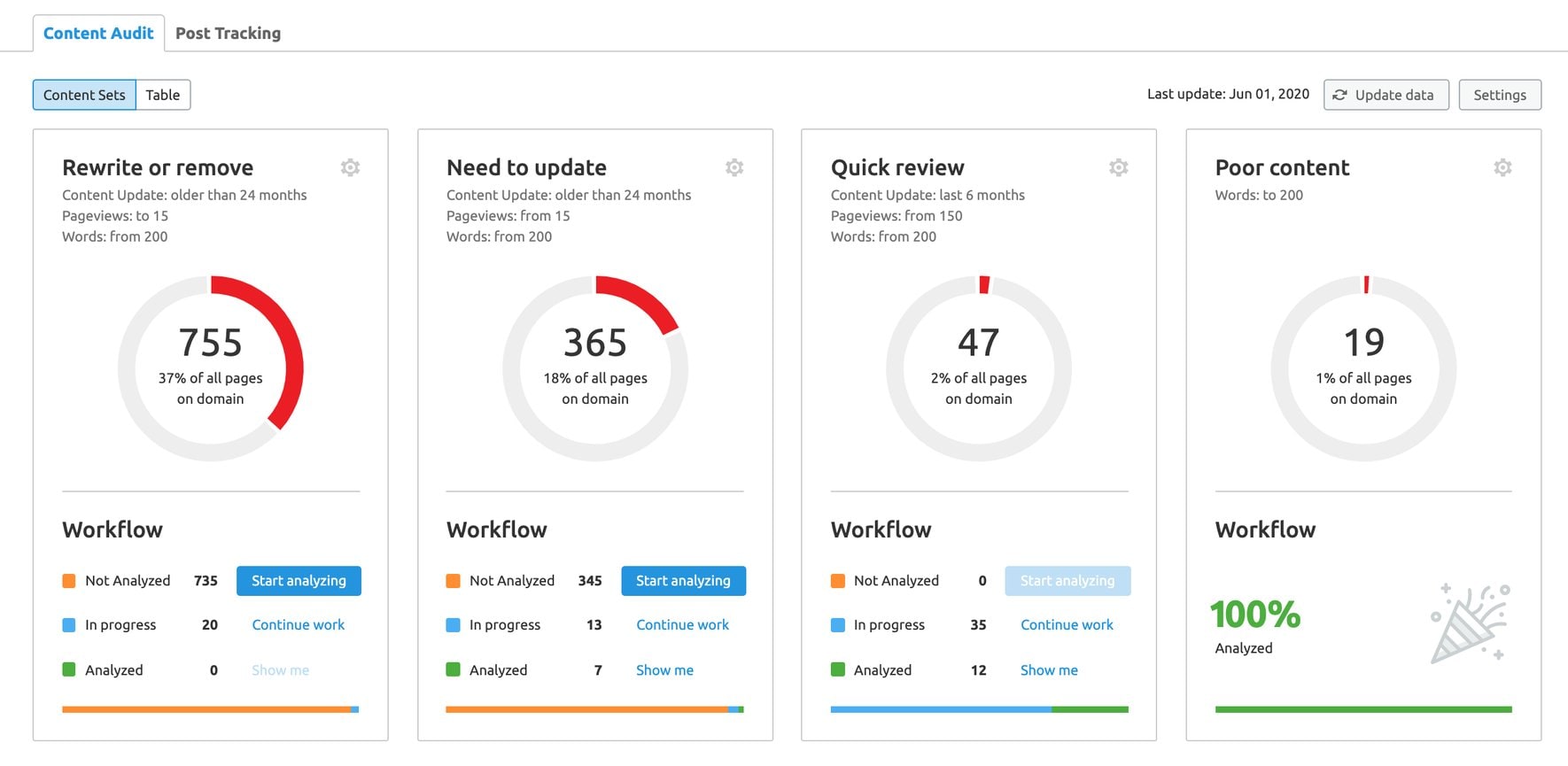
Clicking on any of the sets will present you with a list of recommendations on how to improve the particular piece of content.
You can also connect your Google Analytics and Google Search Console accounts with SEMRush and get more insightful data on how your content performs on Google and social media platforms.

While analyzing your content, do it with a critical mind. Besides looking at the different metrics, try to:
- Identify missing topics – Type of content, topic variation, and marketing funnel content creation.
- Align your website purpose and content – Type of content, topic variation, call to actions, and out-of-date content.
- Analyze post engagement – Page visits, average time on page, page views, bounce rate, social shares, and comments.
- Readjust SEO – Page title, targeted keywords, rankings, internal/external links, broken links, meta description, images, image alt text.
A good rule of thumb is to write down your content goals. As you audit your site, determine if you’re on the right track to reaching them.
Here’s an example:
Kristine sells plants to people who live in the city. Her content purpose is to inform readers about the benefits of owning plants in an apartment.
Kristine started her content strategy 10 months ago. She wants to make sure her content is reaching out to the right audience.
After running an audit, she found many posts being shared by suburban house-owners. Kristine realized that her keywords weren’t targeted towards apartment owners, but house-owners.
To solve this problem, Kristine conducted more audience research. Then, she readjusted her target keywords and social sharing for city-dwellers.
4. Create content that is better and different than competitors
A unique website content strategy is nearly impossible these days. There will always be others who write the same content as you.
The goal is to stand out from your competitors. You can do this by learning from them.
Before you create a post, do a Google search. Search for your topic and other ideas similar to it. Read the most popular posts and ask yourself, “How will my content be more informative? Insightful? Actionable?”
Basically, how will your post be better?
Along with reading other posts, try out these 3 strategies:
Change your angle – Write about your topic from another perspective. Take a different approach to solve a problem, or share a unique experience.
Get readers to leave your post thinking, “I’ve never thought of it like that before.”
Revisit your content purpose – Define what makes your content purpose different from others and use it in your posts.
You can also implement your brand. Show off your personality and write in your own voice and humor. Or, implement brand colors to personalize your blog.
Encourage engagement – The more engagement your web content gets, the more popular it’ll be.
You can increase social sharing and:
- Sum up your content into an image or infographic. Add it to the beginning or end of your post.
- Start a conversation and ask questions. Your readers can answer them in the comment section.
- Put memorable content into quotes and place them throughout your post.
You should add social media sharing icons to promote engagement. As you go through this process, make sure you’re still reaching out to your targeted audience.
Your posts should stand out to the right people.
5. Make your content discoverable
Website content creation is one part of your website marketing strategy. Being discovered is the second part.
Sure, you can reach out to your audience with ads. But the secret is letting your audience find your content on their own.
There are a couple of strategies to help users discover your content:
Schema markup
Schema helps Google and other search engines to understand the meaning of your content and display relevant search results for users.
When you implement a schema markup, your content is more likely to appear in a relevant search.
They also help you create a rich snippet. Rich snippets display other valuable information to your search result.
When you search, “lasagna recipe,” this pops up on Google.
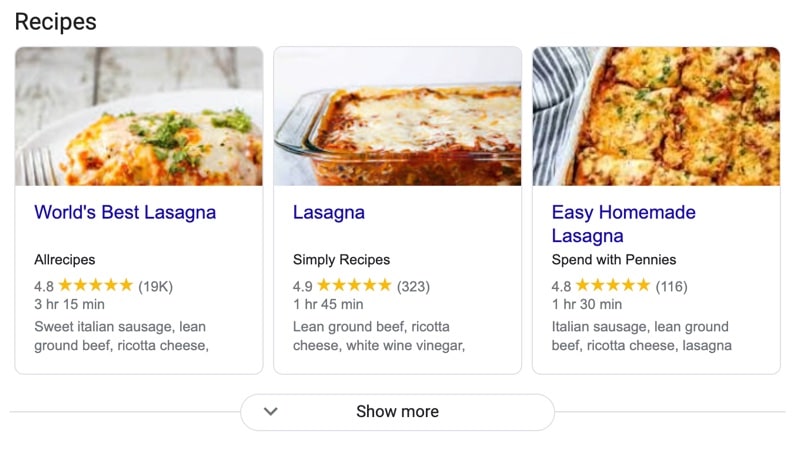
Notice how each result has its own photo and rating—this is a rich snippet. There’s other information than your title, description, and URL.
Rich snippets are best used for:
- How-to articles
- FAQ pages
- Product pages
- Review pages
Site structure
The more web content you create, the more likely it’ll become disorganized. You can avoid this with an optimized site structure.
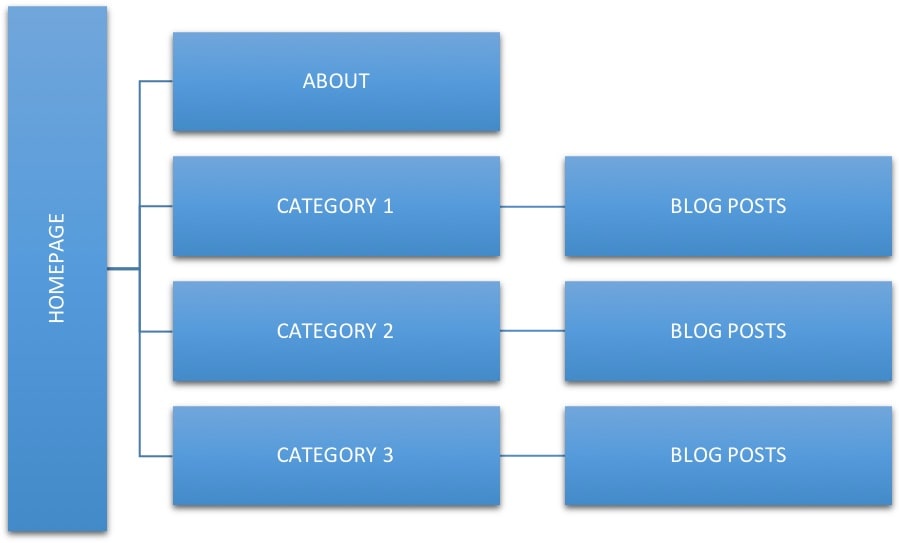
A good site structure declutters your content and helps Google crawl your site. Plus, it helps users read through multiple posts and stay on your site longer.
You can improve your site structure with a hierarchy, content categories, and internal links.
Hierarchy – A hierarchy organizes your content from most important to least important.
Content categories – Content categories split your posts into different topics. For example, if you write about healthy living, you could divide your web content into diet, exercise, mental health, etc.
This helps users find exactly what they’re looking for on your site. It also helps Google identify your content for search.
Internal linking – This links one piece of content to another. It makes it easy for users to click through your content.
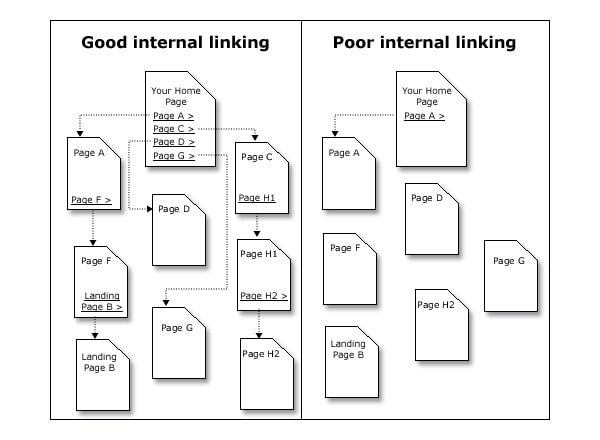
Internal links work best when they’re relevant to one another. If you link random pieces of content together, it’ll confuse your audience and Google. Good internal linking practices can also give you sitelinks in Google search results.
Let’s go back to the healthy living example:
If you wrote a post about running, you could add an internal link to a past article about the best running shoes. A reader who’s interested in running would also be interested in the best running shoes—they’re relevant to each other.
6. Demonstrate your experience and expertise
It’s commonly said that trust is the most important part of any long-term relationship—this includes your customers.
But, like any relationship, trust takes time. You can make this process easier and create educational, consistent, and credible content.
Educational
Successful web content becomes the go-to source for an audience. They answer their reader’s questions and show them how to reach their goals.
When you write a post, show your readers why they should know about X and how to achieve it. Use credible research to back up your work.
Consistent
Long-term relationships work… if you show up. Showing up tells your audience, “I’m here for you, and I will continue to be here for you.”
Along with writing consistent web content, keep up with your readers. Ask them how they’re doing and what they want to learn more about. Listen and answer their questions.
Credible
Back up any claims you make with statistics. This ensures readers that you do your research.
Don’t forget to add an author bio at the end of each article. This puts a face to your brand and boosts your credibility as a writer.
If you continue to support, inform, and show up for your audience, they’ll do the same for you.
7. Speak the user’s language
In other words, be relevant and personable. Revisit your audience research and consider the following:
Demographics
Demographics determine how someone communicates. They also clue you in on your audience’s interests and everyday routine. Use this info to relate to them on a personal level.
For example, if you’re writing about finance, look at your user’s job title. A senior position is more inclined to use industry jargon than an entry-level position.
How they digest content
Analyze what content format your audience prefers—social media, blogging, etc. Look at your data and take note of your most popular content.
Your brand
While it’s necessary to relate to your readers, you should also be yourself.
Apply your own language to your website content strategy. Implement your values throughout your web content and use personal experiences and humor.
Your readers want to get to know you, too.
8. Optimize for SEO
On-page SEO helps both search engines and users understand what your web content is all about.
Google uses this to decide if your content is relevant. And your audience uses on-page SEO to scan your posts.
You might be wondering why someone would scan an article. Think about the last time you read a post. Did you read it word-for-word, or did you skim it?
Many, if not, almost all of you choose the latter. This doesn’t mean your posts are meaningless. But your most valuable content should stand out.

Create a powerful headline
A powerful headline (also referred to as the h1 tag) targets your audience. Focus on a problem, desire, or both.
Something to keep in mind: Don’t add too much info in your headline, it’ll diminish curiosity. Say just enough to hook your reader.
Write subheadings
Subheadings help readers understand your main ideas. Use H2 and H3 headings to divide your web content.
If your post is long (2,000+ words), consider adding a table of contents. This way, your readers can jump around your post.
Use whitespace
Whitespace separates blocks of text into easy-to-read paragraphs. Long paragraphs are hard to digest—divide them into 2-3 sentences.
In addition, keep your sentences short and simple. Don’t write sentences with more than 15 words and avoid complicated vocabulary.
Remember, you want to make your content as easy-to-read as possible.
Insert images
Photos help readers visualize your writing. They’re especially helpful for breaking down a technical idea.
Plus, pages of text are overwhelming. Use images to break up your writing.
Keep these on-page SEO practices handy every time you build website content. They’ll become second-nature to you as you practice.
RESOURCES TO LEARN MORE
- SEO blog writing – simple steps to follow to ensure that everything you write is SEO friendly.
- SEO Content – a comprehensive guide on how to fully optimize your content for search engines.
9. Give user’s options what to do next
This is also known as a call-to-action (CTA). A CTA tells your readers what to do after they read your web page content.
A compelling CTA gives your audience an incentive. In other words, your call to action benefits your reader.
There are 2 ways to do this:
Be specific
What looks better to you?
“Sign up now,” or, “Download your free guide”?
The first option is generic. Readers may wonder what they’re signing up for. But the second option tells them what they’re downloading, and they know it’s free.
Ask yourself how your CTA will benefit your audience and use it in your copy.
Be relevant
General call-to-actions, like social sharing and comments, can be used across all content.
Specific call-to-actions, however, should relate to your article. An example of a specific CTA is signing up for your online course.
Whatever the next step is, make it personal and relatable for your readers. You should also analyze your CTAs to optimize them. You can do this with analytics and A/B testing.
10. Update your content to stay relevant to search queries
Writing for the web isn’t a one and done situation. The most optimized posts are updated every 6-12 months.
These 3 tools will make updating easier:
Editorial calendar

An editorial calendar organizes your content, SEO-optimization, and traffic. You can divide these categories into multiple editorial calendars or combine them into one resource.
Organizing your web page content helps you notice what content and SEO needs updating. Some common updates are:
- Old statistics
- Out-of-date CTAs
- Broken links
- Publish date
I also suggest creating a category for future content. Write down any ideas you have. When you need inspiration, look there.
Auditing
As mentioned in step 3, you should perform a content audit twice a year. You can think of this as a cleansing period—get rid of the content that doesn’t serve your audience or Google.
Repurpose

Good content shouldn’t be used once, but multiple times. Analyze what gets the most traffic and repurpose them into other forms of media.
For example, you could turn a series of blog posts into an eBook. Or, you could create videos for your most popular how-to articles. Repurposing revives golden content for your readers and Google.
Once you’ve updated your content, share your new posts through social media and/or email.
Key Learnings
As you build your website content strategy, keep these 3 things in mind:
Content is more than creation – A complete website content strategy includes continuous auditing and revisions. Your content will evolve as you update your strategy and goals.
Your audience is everything – Writing for the web isn’t about you, it’s about your reader. All of your content decisions should include your audience. You help them, and they’ll help you.
You’re not in this alone – Writing for the web isn’t as easy as it sounds. It takes a lot of time and there will be moments of confusion. Turn to online resources to help you solve any problems and connect with other content creators.

